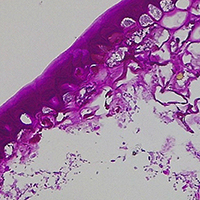A morphological analysis of fresh and brine-cured olives attacked by Bactrocera oleae using light microscopy and ESEM-EDS

Submitted: 8 June 2020
Accepted: 2 September 2020
Published: 23 September 2020
Accepted: 2 September 2020
Abstract Views: 717
PDF: 736
HTML: 5
HTML: 5
Publisher's note
All claims expressed in this article are solely those of the authors and do not necessarily represent those of their affiliated organizations, or those of the publisher, the editors and the reviewers. Any product that may be evaluated in this article or claim that may be made by its manufacturer is not guaranteed or endorsed by the publisher.
All claims expressed in this article are solely those of the authors and do not necessarily represent those of their affiliated organizations, or those of the publisher, the editors and the reviewers. Any product that may be evaluated in this article or claim that may be made by its manufacturer is not guaranteed or endorsed by the publisher.
Similar Articles
- A. Sbarbati, D. Accorsi, D. Benati, L. Marchetti, G. Orsini, G. Rigotti, P. Panettiere, Subcutaneous adipose tissue classification , European Journal of Histochemistry: Vol. 54 No. 4 (2010)
- C. Loreto, L. E. Almeida, M.R. Migliore, M. Caltabiano, R. Leonardi, TRAIL, DR5 and caspase 3-dependent apoptosis in vessels of diseased human temporomandibular joint disc. An immunohistochemical study , European Journal of Histochemistry: Vol. 54 No. 3 (2010)
- M. Riccio, E. Resca, T. Maraldi, A. Pisciotta, A. Ferrari, G. Bruzzesi, A. De Pol, Human dental pulp stem cells produce mineralized matrix in 2D and 3D cultures , European Journal of Histochemistry: Vol. 54 No. 4 (2010)
- Wanchun Wang, Jun Yi, Degang Dong, Wenli Mao, Xuanyu Wang, Zhangren Yan, miRNA-877-5p inhibits malignant progression of prostate cancer by directly targeting SSFA2 , European Journal of Histochemistry: Vol. 65 No. 3 (2021)
- Paolino Ninfali, Anna Panato, Federica Bortolotti, Laura Valentini, Pietro Gobbi, Morphological analysis of the seeds of three pseudocereals by using light microscopy and ESEM-EDS , European Journal of Histochemistry: Vol. 64 No. 1 (2020)
- Yunlong Zhang, Xin He, Jianyu Zou, Jie Yang, Ao Ma, Minghui Tan, Phosphorylation mutation impairs the promoting effect of spastin on neurite outgrowth without affecting its microtubule severing ability , European Journal of Histochemistry: Vol. 67 No. 1 (2023)
- Jianbao Yuan, Linfang Li, Yi Fan, Xinyu Xu, Xiaoqiong Huang, Jiayu Shi, Chuanwei Zhang, Lixin Shi, Yuliang Wang, Effects of artificial light with different spectral compositions on refractive development and matrix metalloproteinase 2 and tissue inhibitor of metalloproteinases 2 expression in the sclerae of juvenile guinea pigs , European Journal of Histochemistry: Vol. 68 No. 3 (2024)
- H. Sawai, N. Domae, Transfer of Fas (CD95) protein from the cell surface to the surface of polystyrene beads coated with anti-Fas antibody clone CH-11 , European Journal of Histochemistry: Vol. 54 No. 1 (2010)
- E. Varricchio, M.G. Russolillo, L. Maruccio, S. Velotto, G. Campanile, M. Paolucci, F. Russo, Immunological detection of m- and µ-calpains in the skeletal muscle of Marchigiana cattle , European Journal of Histochemistry: Vol. 57 No. 1 (2013)
- L.V. Renna, R. Cardani, A. Botta, G. Rossi, B. Fossati, E. Costa, G. Meola, Premature senescence in primary muscle cultures of myotonic dystrophy type 2 is not associated with p16 induction , European Journal of Histochemistry: Vol. 58 No. 4 (2014)
<< < 27 28 29 30 31 32 33 34 35 36 > >>
You may also start an advanced similarity search for this article.

 https://doi.org/10.4081/ejh.2020.3149
https://doi.org/10.4081/ejh.2020.3149










